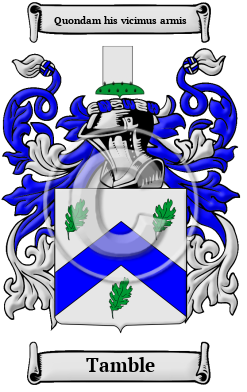| ![Show Contents]() Tamble History, Family Crest & Coats of Arms Tamble History, Family Crest & Coats of Arms
Etymology of TambleWhat does the name Tamble mean? The Celtic origin of the name Tamble was long ago developed in Wales. This surname comes from the names Tam, Thom, and Tom, which are pet forms of the personal name Thomas. The surname Tamble features a double diminutive, formed from the suffixes -el and -in. 1 2 3 Early Origins of the Tamble familyThe surname Tamble was first found in Breconshire (Welsh: Sir Frycheiniog), a traditional county in southern Wales, which takes its name from the Welsh kingdom of Brycheiniog (5th-10th centuries), where they were conjecturally descended from Elystan Glodrydd, Prince of Fferllys, through Thomas of Llyn Madoc. Hence Tomlyn, in North Wales was commonly replaced by an 'a' hence Tamlyn. Early English rolls provide us a glimpse of the spelling variations used through Medieval times. Today we typically need to look beyond the spellings of these entries and concentrate on a phonetic appreciation of the names. Peter Tamelyn was listed in the Subsidy Rolls for Suffolk in 1327. 4 "The 14th - cent. English forms are Tomelyn, Thomelyn, Tomlyn, Thomlyn." 2 In Somerset, John Tomelyn and John Thomelyn were both listed there 1 Edward III (in the first year of King Edward III's reign.) 5 Early History of the Tamble familyThis web page shows only a small excerpt of our Tamble research. Another 57 words (4 lines of text) covering the years 1563, 1621, 1629, 1650, 1750, 1762, 1763, 1772, 1774, 1787, 1803, 1804, 1811, 1815, 1820, 1827, 1828, 1841 and 1872 are included under the topic Early Tamble History in all our PDF Extended History products and printed products wherever possible. Tamble Spelling VariationsThere are relatively few surnames native to Wales, but they have an inordinately large number of spelling variations. Early variations of Welsh surnames can be explained by the fact that very few people in the early Middle Ages were literate. Priests and the few other literate people were responsible for recording names in official documents. And because most people could not specific how to properly record their names it was up to the individual recorder of that time to determine how a spoken name should be recorded. Variations due to the imprecise or improper recording of a name continued later in history when names originally composed in the Brythonic Celtic, language of Wales, known by natives as Cymraeg, were transliterated into English. Welsh names that were documented in English often changed dramatically since the native language of Wales, which was highly inflected, did not copy well. Occasionally, however, spelling variations were carried out according to an individual's specific design: a branch loyalty within the family, a religious adherence, or even patriotic affiliations could be indicated by minor variations. The spelling variations of the name Tamble have included Tamblyn, Taplin, Tapling, Tomblyn, Tomlyn, Tomline and many more. Early Notables of the Tamble familyRichard Tomlins or Tomlyns (1563-1650), an English lawyer and politician who sat in the House of Commons between 1621 and 1629; and Sir George Pretyman Tomline (1750-1828), born George Pretyman, Bishop of Lincoln (1787-1820.) He was "tutor of the younger Pitt, and bishop of Winchester, was the son of George Pretyman of Bury St. Edmunds, by his wife Susan, daughter of John Hubbard. His father represented an ancient and respectable Suffolk family which had held land at Bacton in Suffolk from the fifteenth century. Tomline (who until 1803 bore the name of Pretyman) was born at Bury St. Edmunds on 9...
Another 176 words (13 lines of text) are included under the topic Early Tamble Notables in all our PDF Extended History products and printed products wherever possible. Migration of the Tamble familyMany Welsh families joined their Scottish and Irish neighbors during the late 1800s and early 1900s in seeking refuge in North America. Like the Irish and Scottish, many Welsh anxiously awaited the work, freedom, and opportunities that they believed lay in North America. Those who did journey over to the United States and what became known as Canada often realized those dreams, but only through much toil and perseverance. Whenever and however these Welsh immigrants arrived in North America, they were instrumental in the creation of the industry, commerce, and cultural heritage within those two developing nations. In the immigration and passenger lists a number of early immigrants bearing the name Tamble were found: Henry Tomlin, who arrived in Virginia in 1638; Robert Tomlin arrived in Maryland in 1685; Matthew Tomlin arrived in Virginia in 1636; Sara Thomblin arrived in Virginia in 1650.
The motto was originally a war cry or slogan. Mottoes first began to be shown with arms in the 14th and 15th centuries, but were not in general use until the 17th century. Thus the oldest coats of arms generally do not include a motto. Mottoes seldom form part of the grant of arms: Under most heraldic authorities, a motto is an optional component of the coat of arms, and can be added to or changed at will; many families have chosen not to display a motto.
Motto: Quondam his vicimus armis
Motto Translation: We formerly conquered with these arms.
- Bardsley, C.W, A Dictionary of English and Welsh Surnames: With Special American Instances. Wiltshire: Heraldry Today, 1901. Print. (ISBN 0-900455-44-6)
- Harrison, Henry, Surnames of the United Kingdom: A Concise Etymological Dictionary Baltimore: Geneological Publishing Company, 2013. Print
- Smith, Eldson Coles, New Dictionary of American Family Names New York: Harper & Row, 1956. Print
- Reaney, P.H and R.M. Wilson, A Dictionary of English Surnames. London: Routledge, 1991. Print. (ISBN 0-415-05737-X)
- Dickinson, F.H., Kirby's Quest for Somerset of 16th of Edward the 3rd London: Harrison and Sons, Printers in Ordinary to Her Majesty, St, Martin's Lane, 1889. Print.
 |

